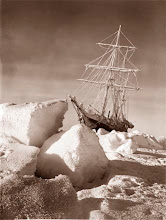
The
Toolik Lake Field Station is an
idyllic place for scientists looking to study everything from fish, to shrubs, to squirrels to microbes. Tucked well into the Arctic Circle, it goes months in dark and extreme cold and then in the summer basks in 24-hour sunlight, an explosion in plant growth across its undulating tundra and an invasion of curious researchers.
And clouds of
mosquitoes, but more on that in another post.
The camp is a base for investigative teams -- mostly senior university faculty and their young assistants -- intrigued with all that happens to the ecology of a region that encompasses tundra and
boreal forest. The long-term nature of many of the studies puts
Toolik in a key position to probe the mysteries of climate change.
It's a scavenged place, converted from a highway construction camp in the mid-'70s (much of the settlement of northern Alaska relates back to the bounty of oil and the building of the pipeline), it can be home to as many as 125 people in the summer. But it's usually about half that.
The population is all about science, a hardy group of researchers who tromp over mountains and into streams in the name of biology. Fashion statements are limited to the works of
Goretex, fleece and
Carhart
.
From 10-14 people tend to the chores so scientists are free for research. It's got two large generators running around the clock on diesel. The chow is hearty and plentiful, made mostly from scratch. Groceries come in 18-wheelers twice weekly from Fairbanks.
The buildings are utilitarian. Largely trailers and semi-permanent tents. To walk through is to imagine a battlefield Army encampment that's fallen into the hands of science
guerrillas.
Water is plentiful, drawn from the lake and treated for drinking. Sewage is another matter. The grey water is trucked at great expense to
Deadhorse three hours to the north. So
campfolk are limited to two very short showers a week. Trash is either incinerated or trucked south to Fairbanks. Again, pricey stuff.
For the last two years, the camp has been open year-round, meaning about 16 sturdy folks hang through the winter. Winds howl at 40 mph. Last year the thermometers maxed out at 60 below.
Summer time is far nicer than you'd expect in the Arctic. T-shirts and a light jacket will do most of the time.
But the physically taxing work and lack of showers can foster a bit of an aroma. The population turns to, well, let's look what Mike
Mansur wrote when he first planted the Star flag in the Arctic in 2000:
"Four nights a week, on the shore of this glistening lake, some of the world's leading scientists gather in a small, wooden building and take off all their clothes." It's the sauna. A place to warm up, wash off with biodegradable soap. The bravest jump in the lake. (Your intrepid reporter promises to take the plunge. As a favor to you, he will post no photos.)
It could be said there's no nightlife here, but only in the sense that there's no night. But bring in their own alcohol can drink it here, though rowdiness is discouraged. There are
occasionally dances. There's a full drum set, an electric guitar and base, three mandolins and (surely there has to be some sort ecological law forbidding this next one) a banjo.
Mostly, folks get along. Camp manager Chad
Diesinger (fresh from the scaling of Denali) says people sometimes don't get along. A few aren't suited for the close quarters and lack of privacy. But generally, it's a granite-tough crowd infatuated with wilderness.
"I tell people to get out and hike a little bit,"
Diesinger says. "Get where you can't see camp anymore. Enjoy it."
 the sweat of a Mongolian ox. I've heard about 'em. Go ahead. You'll swat like the rest of us.)
the sweat of a Mongolian ox. I've heard about 'em. Go ahead. You'll swat like the rest of us.)






